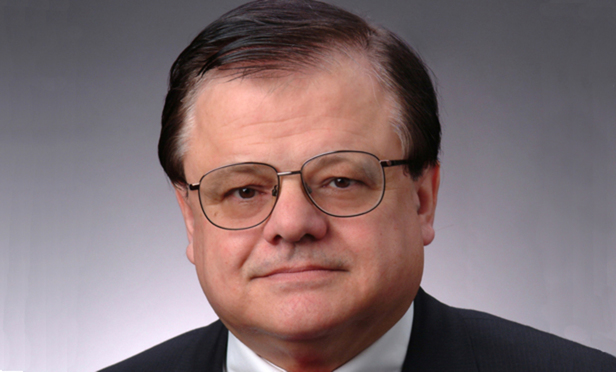New York's 'Professional Reliability' Rule
In his Evidence column, Michael J. Hutter discusses whether out-of-court material may be the sole or principal basis for an expert's opinion.
August 01, 2018 at 02:45 PM
2 minute read
 People v. Sugden Sugden Sugden See Sugden See, e.g., Straus v. Strauss st Diagne v. J.T.S. Trucking, st A Tech Concrete Co. v. Tilcon N.Y. Tassone v. Mid-Valley Oil Co. People v. Goldstein Sugden Tornatore v. Cohen th Tornatore's
People v. Sugden Sugden Sugden See Sugden See, e.g., Straus v. Strauss st Diagne v. J.T.S. Trucking, st A Tech Concrete Co. v. Tilcon N.Y. Tassone v. Mid-Valley Oil Co. People v. Goldstein Sugden Tornatore v. Cohen th Tornatore's 'Tornatore'
Tornatore, Sugden's Id'Of a Kind' Foundation Element
Mroz v. 3M th Goldstein Id. IdReliability Foundation Element
Sugden Hambsch v. New York City Transit Auth Hambsch Tornatore Borden v. Brady Tornatore Borden Borden see People v. Howard see O'Brien v. Mbuga see Matter of State of New York v. Floyd Y Tornatore Tornatore'Not Sole/Principal Basis' Limitation
See Brown v. County of Albany Borden Borden Tornatore TornatoreConclusion
Sugden Sugden Tornatore Michael J. Hutter is a Professor of Law at Albany Law School where he teaches, among other courses, Evidence and New York Practice, and is Special Counsel to Powers & Santola. He is currently serving as the Reporter to the OCA Judicial Committee preparing the Guide to NY Evidence.This content has been archived. It is available through our partners, LexisNexis® and Bloomberg Law.
To view this content, please continue to their sites.
Not a Lexis Subscriber?
Subscribe Now
Not a Bloomberg Law Subscriber?
Subscribe Now
NOT FOR REPRINT
© 2025 ALM Global, LLC, All Rights Reserved. Request academic re-use from www.copyright.com. All other uses, submit a request to [email protected]. For more information visit Asset & Logo Licensing.
You Might Like
View All

The Unraveling of Sean Combs: How Legislation from the #MeToo Movement Brought Diddy Down

When It Comes to Local Law 97 Compliance, You’ve Gotta Have (Good) Faith
8 minute read
Trending Stories
- 1Pa. Superior Court: Sorority's Interview Notes Not Shielded From Discovery in Lawsuit Over Student's Death
- 2Kraken’s Chief Legal Officer Exits, Eyes Role in Trump Administration
- 3DOT Nominee Duffy Pledges Safety, Faster Infrastructure Spending in Confirmation Hearing
- 4'Younger and Invigorated Bench': Biden's Legacy in New Jersey Federal Court
- 5'Every Single Judge on Board': First-Impression Case Revived
Who Got The Work
J. Brugh Lower of Gibbons has entered an appearance for industrial equipment supplier Devco Corporation in a pending trademark infringement lawsuit. The suit, accusing the defendant of selling knock-off Graco products, was filed Dec. 18 in New Jersey District Court by Rivkin Radler on behalf of Graco Inc. and Graco Minnesota. The case, assigned to U.S. District Judge Zahid N. Quraishi, is 3:24-cv-11294, Graco Inc. et al v. Devco Corporation.
Who Got The Work
Rebecca Maller-Stein and Kent A. Yalowitz of Arnold & Porter Kaye Scholer have entered their appearances for Hanaco Venture Capital and its executives, Lior Prosor and David Frankel, in a pending securities lawsuit. The action, filed on Dec. 24 in New York Southern District Court by Zell, Aron & Co. on behalf of Goldeneye Advisors, accuses the defendants of negligently and fraudulently managing the plaintiff's $1 million investment. The case, assigned to U.S. District Judge Vernon S. Broderick, is 1:24-cv-09918, Goldeneye Advisors, LLC v. Hanaco Venture Capital, Ltd. et al.
Who Got The Work
Attorneys from A&O Shearman has stepped in as defense counsel for Toronto-Dominion Bank and other defendants in a pending securities class action. The suit, filed Dec. 11 in New York Southern District Court by Bleichmar Fonti & Auld, accuses the defendants of concealing the bank's 'pervasive' deficiencies in regards to its compliance with the Bank Secrecy Act and the quality of its anti-money laundering controls. The case, assigned to U.S. District Judge Arun Subramanian, is 1:24-cv-09445, Gonzalez v. The Toronto-Dominion Bank et al.
Who Got The Work
Crown Castle International, a Pennsylvania company providing shared communications infrastructure, has turned to Luke D. Wolf of Gordon Rees Scully Mansukhani to fend off a pending breach-of-contract lawsuit. The court action, filed Nov. 25 in Michigan Eastern District Court by Hooper Hathaway PC on behalf of The Town Residences LLC, accuses Crown Castle of failing to transfer approximately $30,000 in utility payments from T-Mobile in breach of a roof-top lease and assignment agreement. The case, assigned to U.S. District Judge Susan K. Declercq, is 2:24-cv-13131, The Town Residences LLC v. T-Mobile US, Inc. et al.
Who Got The Work
Wilfred P. Coronato and Daniel M. Schwartz of McCarter & English have stepped in as defense counsel to Electrolux Home Products Inc. in a pending product liability lawsuit. The court action, filed Nov. 26 in New York Eastern District Court by Poulos Lopiccolo PC and Nagel Rice LLP on behalf of David Stern, alleges that the defendant's refrigerators’ drawers and shelving repeatedly break and fall apart within months after purchase. The case, assigned to U.S. District Judge Joan M. Azrack, is 2:24-cv-08204, Stern v. Electrolux Home Products, Inc.
Featured Firms
Law Offices of Gary Martin Hays & Associates, P.C.
(470) 294-1674
Law Offices of Mark E. Salomone
(857) 444-6468
Smith & Hassler
(713) 739-1250






